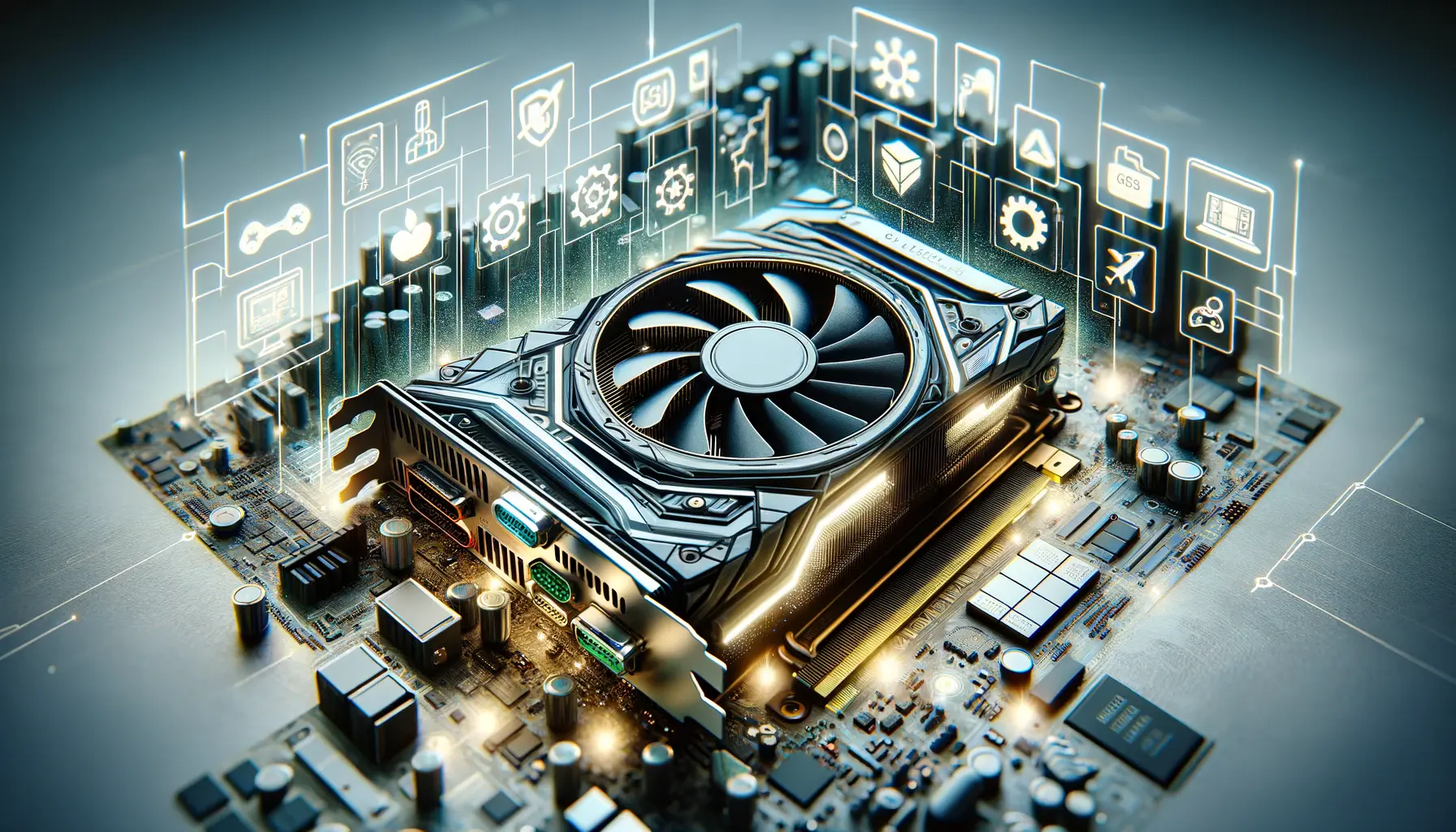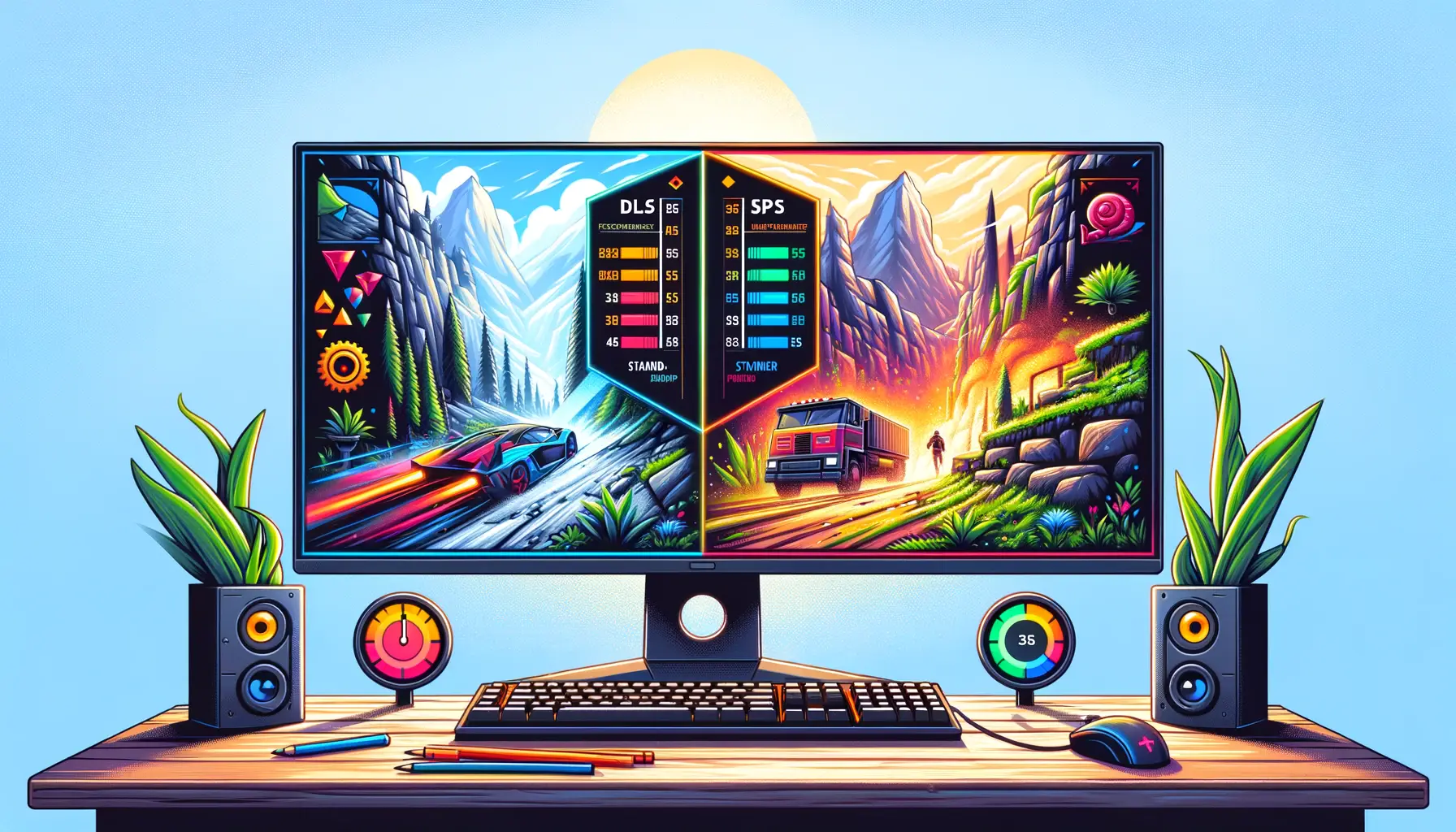As the gaming industry continues to evolve, the demand for higher frame rates and better graphics without compromising performance has led to significant technological advancements.
One such innovation that has caught the attention of gamers and developers alike is NVIDIA’s Deep Learning Super Sampling (DLSS) technology, particularly its latest iteration, DLSS 3.
This technology represents a leap forward in rendering efficiency, offering a blend of improved image quality and performance enhancements that are particularly beneficial for users of NVIDIA’s GeForce RTX series GPUs.
DLSS 3, developed by NVIDIA, leverages artificial intelligence and machine learning to upscale images in real-time, allowing games to run at higher frame rates without the need for powerful hardware.
This not only makes gaming more accessible to those with less powerful PCs but also enhances the gaming experience for those with high-end systems.
The compatibility of DLSS 3 with various hardware and software configurations is a topic of much interest and discussion within the gaming community.
Understanding DLSS 3 Technology
At its core, DLSS 3 utilizes a unique AI-driven approach to increase gaming performance.
By rendering fewer pixels and then using AI to upscale the image to the desired resolution, DLSS 3 allows games to achieve higher frame rates without sacrificing visual fidelity.
This process is particularly effective in graphically intensive games where maintaining high frame rates is challenging.
The technology behind DLSS 3 is built on the foundation of NVIDIA’s proprietary Tensor Cores, available exclusively on GeForce RTX GPUs.
These cores are specially designed to handle AI and machine learning tasks efficiently, making them ideal for the DLSS upscaling process.
The result is a smoother, more immersive gaming experience, even in demanding titles that feature complex visuals and ray tracing.
Key Components of DLSS 3
DLSS 3 comprises several key components that work together to enhance game performance.
The first is the AI upscaling, which intelligently increases the resolution of rendered frames.
Another critical component is Frame Generation, which creates additional frames between existing ones to boost frame rates further.
Lastly, NVIDIA Reflex technology reduces system latency, ensuring that the increase in frame rates does not come at the cost of responsiveness.
Together, these components make DLSS 3 a comprehensive solution for improving gaming performance.
By addressing both the visual quality and responsiveness of games, DLSS 3 offers a balanced approach to enhancing the gaming experience across a wide range of titles.
DLSS 3 represents a significant advancement in gaming technology, offering enhanced performance and visual quality through AI-driven upscaling and frame generation.
DLSS 3 Compatibility with GPUs
One of the most frequently asked questions regarding DLSS 3 revolves around its compatibility with various NVIDIA GPUs.
Given its advanced nature, DLSS 3 requires specific hardware capabilities to function correctly.
Primarily, it is designed to work with NVIDIA’s GeForce RTX 40 series GPUs, which are equipped with the necessary Tensor Cores and AI processing power to support the technology’s demands.
However, NVIDIA has made strides in ensuring that DLSS 3 offers benefits across a broader range of its GPU lineup.
This includes compatibility with older GeForce RTX 20 and 30 series cards, albeit with some limitations in terms of the technology’s full capabilities.
The key to DLSS 3’s compatibility lies in the architecture of these GPUs, which includes support for AI-driven processes essential for DLSS 3’s performance enhancements.
Supported NVIDIA GPU Series
- GeForce RTX 40 Series: Full compatibility with DLSS 3, including AI upscaling and Frame Generation.
- GeForce RTX 30 Series: Partial compatibility, offering significant performance improvements with DLSS 3, but without the full suite of features available to the 40 series.
- GeForce RTX 20 Series: Limited compatibility, focusing mainly on AI upscaling aspects of DLSS 3.
It’s important for gamers to understand the level of support their GPU offers for DLSS 3 to set realistic expectations regarding performance improvements in games.
While the latest GPUs will benefit the most from DLSS 3, older models will still see noticeable enhancements in frame rates and image quality.
Game Support and Availability
The effectiveness of DLSS 3 is not solely dependent on the GPU; it also requires game developers to integrate the technology into their titles.
NVIDIA has been working closely with developers across the industry to ensure a growing library of games supports DLSS 3.
This collaboration has resulted in a diverse range of games, from AAA titles to indie gems, benefiting from the performance enhancements DLSS 3 provides.
- AAA titles with complex graphics and ray tracing, such as “Cyberpunk 2077” and “Fortnite,” have seen significant performance boosts with DLSS 3.
- Indie games, which might not have the same graphical intensity but still benefit from higher frame rates and improved image quality.
While DLSS 3 offers compatibility across a range of GPUs, the extent of its benefits varies depending on the specific hardware and game support.
DLSS 3 and Gaming Performance
The primary allure of DLSS 3 lies in its profound impact on gaming performance.
By intelligently upscaling lower-resolution images, DLSS 3 allows games to run at higher frame rates without a noticeable loss in image quality.
This section delves into the tangible benefits gamers can expect when enabling DLSS 3 in supported titles, highlighting its transformative effect on gameplay smoothness and visual fidelity.
Frame Rate Improvements
DLSS 3’s most immediate benefit is the significant boost in frame rates it delivers.
By rendering games at a lower native resolution and then upscaling to the target resolution, DLSS 3 reduces the graphical workload on the GPU.
This process, combined with the generation of intermediate frames, results in smoother gameplay, even in graphically intensive scenes.
Gamers can expect:
- Increased frame rates, often doubling the performance compared to native rendering without compromising on visual quality.
- Enhanced gameplay smoothness, making fast-paced action and competitive gaming experiences more responsive and enjoyable.
Visual Quality Maintenance
Despite the focus on performance, DLSS 3 does not neglect visual quality.
NVIDIA’s AI algorithms have been trained on vast datasets to accurately upscale images, preserving detail and minimizing artifacts.
This ensures that:
- Textures, character models, and environmental details remain sharp and clear, closely matching the quality of native high-resolution rendering.
- Visual artifacts are minimized, avoiding common upscaling issues such as blurring or the “soap opera effect.”
Latency Considerations
With the introduction of Frame Generation, there were initial concerns about potential increases in input latency.
However, NVIDIA Reflex technology, integrated into DLSS 3, addresses these concerns by optimizing the rendering pipeline to reduce latency.
This results in:
- A gaming experience that feels as responsive as it is visually smooth, crucial for competitive gaming where every millisecond counts.
- Minimal perceptible delay between player inputs and on-screen action, ensuring that the benefits of higher frame rates are not offset by increased latency.
The balance DLSS 3 strikes between enhancing performance and maintaining visual quality, all while keeping latency in check, underscores NVIDIA’s commitment to pushing the boundaries of gaming technology.
DLSS 3 in Esports and Competitive Gaming
Esports and competitive gaming demand not just precision and skill from players but also the highest level of performance from their gaming rigs.
DLSS 3 emerges as a game-changer in this arena, offering the dual benefits of high frame rates and low latency, which are critical for competitive play.
This section explores how DLSS 3 is set to redefine the esports landscape by enhancing player performance and viewer experience.
Boosting Player Performance
For competitive gamers, every frame per second (FPS) can make a difference between victory and defeat.
DLSS 3 enables esports titles to run at significantly higher FPS, providing a smoother experience that can help players react more quickly to in-game events.
The technology ensures:
- A noticeable improvement in game responsiveness, allowing for quicker decision-making and execution.
- Reduced visual clutter, making it easier to spot opponents and important visual cues.
Moreover, the integration of NVIDIA Reflex with DLSS 3 minimizes system latency, further sharpening the competitive edge for players by ensuring their actions are reflected on-screen with minimal delay.
Enhancing the Spectator Experience
Esports isn’t just about the competitors; it’s also a spectator sport.
DLSS 3 enhances the viewing experience by enabling higher-quality streams and broadcasts.
With games running smoothly at higher frame rates and resolutions, spectators can enjoy crystal-clear visuals that make following the fast-paced action easier.
This improvement is crucial for:
- Streamers and content creators who can now deliver higher quality content to their audience.
- Esports event organizers who aim to provide the best possible viewing experience to fans watching online or in-person.
Future of Esports with DLSS 3
The adoption of DLSS 3 in esports could lead to a new standard in competitive gaming, where high performance and visual fidelity are not mutually exclusive.
As more games integrate DLSS 3, we could see:
- A leveling of the playing field, where hardware limitations become less of a barrier to competitive success.
- Increased accessibility to high-quality esports experiences, both for players and viewers, potentially driving further growth in the esports industry.
DLSS 3’s impact on esports and competitive gaming extends beyond just the technical benefits; it enhances the overall ecosystem, making competitive gaming more accessible and enjoyable for all involved.
DLSS 3 and Game Development
The advent of DLSS 3 not only revolutionizes the gaming experience for players but also significantly impacts game development.
By offering a powerful tool that balances performance with high-quality visuals, DLSS 3 enables developers to push the boundaries of game design and graphics.
This section delves into how DLSS 3 is influencing the creative and technical processes behind game development.
Empowering Creative Vision
DLSS 3 allows game developers to realize their creative visions without being constrained by current hardware limitations.
With the ability to render games at lower resolutions and upscale them intelligently, developers can incorporate more detailed textures, complex models, and advanced lighting effects without worrying about performance hits.
This freedom leads to:
- Richer, more immersive game worlds that were previously too resource-intensive to implement.
- Enhanced artistic expression, enabling developers to deliver their intended visual experience to the player without compromise.
Furthermore, the integration of DLSS 3 encourages innovation in game design, allowing for more dynamic and interactive environments that can react in real-time to player actions.
Streamlining Development Workflows
DLSS 3 also streamlines the game development workflow by reducing the need for manual optimization.
Traditionally, developers spend considerable time optimizing game performance across a range of hardware configurations.
DLSS 3 automates much of this process, enabling:
- More efficient use of development resources, allowing teams to focus on content creation and game mechanics.
- Quicker adaptation to new hardware technologies, as DLSS 3 is designed to leverage the latest advancements in AI and machine learning.
This efficiency not only speeds up the development cycle but also ensures that games can be more easily updated and maintained post-launch, keeping pace with evolving hardware capabilities.
Enhancing Cross-Platform Development
While DLSS 3 is specific to NVIDIA’s RTX GPUs, its principles of performance optimization and visual enhancement inform broader trends in cross-platform game development.
Developers can apply the insights gained from working with DLSS 3 to optimize games for a variety of platforms, including:
- Consoles, where similar upscaling and performance optimization techniques can improve game fidelity and fluidity.
- Mobile devices, leveraging AI-driven upscaling to deliver high-quality gaming experiences on less powerful hardware.
DLSS 3 is not just a tool for enhancing game performance; it’s a catalyst for innovation in game development, pushing the industry towards more visually stunning and immersive experiences.
Challenges and Considerations
While DLSS 3 offers numerous benefits, its implementation and adoption come with challenges and considerations.
Understanding these factors is crucial for both developers and gamers to fully leverage the technology’s potential while being mindful of its limitations.
This section explores some of the key challenges and considerations associated with DLSS 3.
Hardware Requirements
The foremost consideration for utilizing DLSS 3 is the hardware requirement.
As a technology built on NVIDIA’s RTX architecture, DLSS 3 requires a compatible GeForce RTX GPU to function.
This means that:
- Players without RTX GPUs will not be able to take advantage of DLSS 3, potentially creating a divide in the gaming experience between different hardware users.
- There is an inherent cost associated with upgrading to or purchasing new hardware capable of supporting DLSS 3, which may not be feasible for all gamers.
These hardware requirements necessitate a balance between adopting the latest technologies and ensuring accessibility for a broad gaming audience.
Game Integration
Another challenge lies in the integration of DLSS 3 into games.
For DLSS 3 to work, game developers must actively choose to support the technology in their titles.
This integration process involves:
- Technical adaptation, where developers must work closely with NVIDIA to implement DLSS 3 within their game engines.
- Quality assurance testing to ensure that the implementation of DLSS 3 does not negatively impact the game’s visual fidelity or performance.
This requirement for active integration means that not all games will benefit from DLSS 3, particularly older titles or those from developers who choose not to adopt the technology.
User Awareness and Education
Finally, there is a need for increased user awareness and education regarding DLSS 3.
Many gamers may not be familiar with the technology or how to enable it in their games.
To address this, efforts must be made to:
- Inform gamers about the benefits of DLSS 3 and how it can enhance their gaming experience.
- Provide clear instructions and support for enabling DLSS 3 in games, ensuring that users can easily take advantage of the technology.
Overcoming these challenges requires collaboration between NVIDIA, game developers, and the gaming community to ensure that DLSS 3’s benefits are fully realized and accessible to as many players as possible.
Misconceptions about DLSS 3, such as it being solely a tool for high-end gaming rigs, need to be addressed to broaden its appeal and adoption.
Future Directions of DLSS Technology
The continuous evolution of Deep Learning Super Sampling (DLSS) technology, culminating in the release of DLSS 3, marks a significant milestone in gaming and graphics rendering.
However, the journey doesn’t end here.
The future of DLSS technology holds promising advancements and potential shifts in the gaming landscape.
This section explores the anticipated directions in which DLSS technology might evolve, shaping the future of gaming and content creation.
Broader Adoption and Integration
As DLSS technology matures, its adoption is expected to become more widespread across the gaming industry.
Future iterations of DLSS could see:
- Increased integration in a wider array of games, including indie titles and AAA blockbusters, enhancing performance and visual quality across the board.
- Further collaboration between NVIDIA and game developers to streamline the integration process, making it easier for developers to implement DLSS in their titles.
This broader adoption will likely result in DLSS becoming a standard feature in game development and optimization, offering benefits to a larger segment of the gaming community.
Advancements in AI and Machine Learning
The core of DLSS technology is its AI-driven approach to image upscaling and frame generation.
Future developments in AI and machine learning could lead to:
- Even more efficient and accurate upscaling algorithms, further closing the gap between native and upscaled image quality.
- Reductions in latency and improvements in frame generation, enhancing the responsiveness of games utilizing DLSS.
These advancements will not only refine the performance of DLSS but also expand its applicability to other areas of content creation, such as virtual reality and film production.
Expansion Beyond NVIDIA Hardware
While DLSS technology is currently exclusive to NVIDIA’s RTX series GPUs, the future could see similar technologies being developed for a broader range of hardware.
This expansion might include:
- Adoption of similar upscaling and frame generation techniques by other GPU manufacturers, fostering competition and innovation in the field.
- Development of open standards for AI-driven rendering technologies, making them accessible to a wider array of devices and platforms.
Such an expansion would not only democratize access to advanced rendering technologies but also push the entire industry towards more efficient and visually stunning graphics solutions.
The potential of DLSS technology extends far beyond its current capabilities, promising to revolutionize not just gaming but all forms of digital media that rely on high-quality, efficient rendering.
Embracing the Future with DLSS 3
The journey through the intricacies of DLSS 3 Compatibility and its impact across various facets of gaming and development unveils a future ripe with potential.
As we stand on the cusp of new advancements in gaming technology, DLSS 3 emerges not just as a feature but as a cornerstone for the next generation of gaming experiences.
Its role in shaping the future of gaming, from performance enhancements to the democratization of high-quality gaming experiences, is undeniable.
The Transformative Impact of DLSS 3
DLSS 3’s introduction into the gaming world has been nothing short of revolutionary.
By leveraging AI to enhance game performance and visual fidelity, NVIDIA has set a new standard for what gamers can expect from their hardware.
The compatibility of DLSS 3 with a range of NVIDIA GPUs ensures that a wide audience can experience these benefits, bridging the gap between hardware generations and making cutting-edge gaming accessible to more players.
Key Takeaways
- DLSS 3’s AI-driven approach offers a significant boost in performance, enabling games to run at higher frame rates without sacrificing visual quality.
- The technology’s compatibility with NVIDIA’s RTX series GPUs democratizes access to high-end gaming experiences, making them available to a broader audience.
- As game developers continue to integrate DLSS 3 into their titles, players can expect a growing library of games that offer enhanced visuals and smoother gameplay.
- The future of DLSS technology promises even greater advancements, with potential applications extending beyond gaming to other areas of digital media.
In conclusion, DLSS 3 Compatibility represents a pivotal moment in gaming technology, offering a glimpse into a future where the boundaries of performance and visual quality are continually expanded.
As NVIDIA and the gaming community embrace DLSS 3, the potential for transformative gaming experiences becomes increasingly tangible.
With each advancement, DLSS technology reaffirms its role as a key driver of innovation, setting the stage for an exciting future in the world of gaming.
DLSS 3 Compatibility FAQs
Explore the most common inquiries about DLSS 3 Compatibility to better understand how this groundbreaking technology enhances your gaming experience.
No, DLSS 3 is not backward compatible. It requires DLSS 2 to function and is designed specifically for NVIDIA’s RTX 40-series GPUs.
Yes, DLSS 3 works across NVIDIA’s RTX 40-series laptop and desktop graphics cards, offering enhanced gaming performance on both platforms.
Over 35 games and applications have added support for DLSS 3, with more titles expected to integrate this technology in the future.
Yes, DLSS 3 is exclusive to NVIDIA’s “Ada Lovelace” RTX 40-series graphics cards and is not available for older GPU models.
DLSS 3 is designed for RTX 40-series GPUs. While DLSS technology is available for RTX 20 and 30 series, DLSS 3’s full feature set, including Frame Generation, is not supported.
To enable DLSS 3, you need an NVIDIA GeForce RTX 40-series GPU and a game that supports DLSS 3 technology.
Yes, gamers can adjust DLSS 3 settings within supported games to balance between performance, image quality, and latency according to their preference.
DLSS 3 introduces AI-driven Frame Generation and improved upscaling techniques, offering significant performance improvements over previous versions without compromising image quality.













